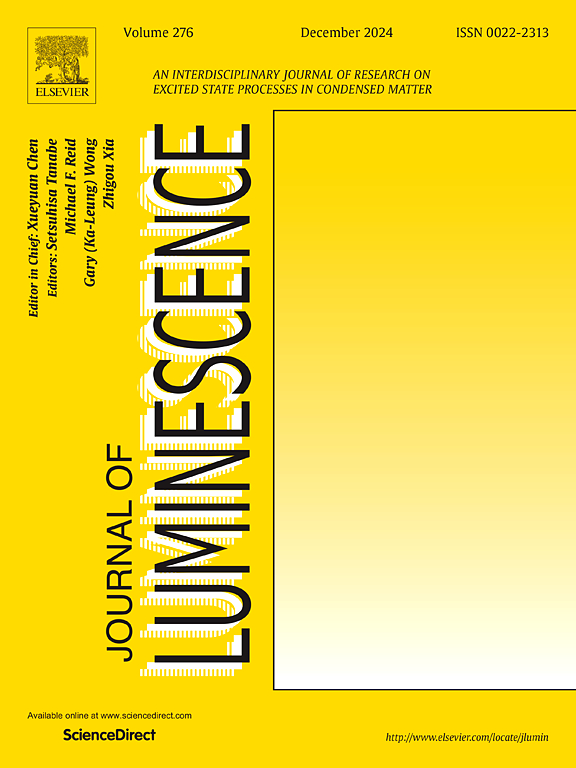The effect of Cr content on the activation energy of order-disorder transition in Mg-Al spinel
IF 3.3
3区 物理与天体物理
Q2 OPTICS
引用次数: 0
Abstract
The order-disorder transition (ODT) in spinel is a critical physical characteristic that significantly affects its properties and applications. Although activation energy—a key thermodynamic parameter of ODT—is reported to be influenced by Cr content, the relationship between these two factors remains unclear. In this work, six natural Mg-Al spinel samples with varying Cr contents were studied. Each sample was cut into eight slices and heated to seven different temperatures (550–850 °C), creating a stepwise increase in the degree of disorder. Photoluminescence (PL) spectra were subsequently collected at liquid nitrogen temperature. The intensity of the N peaks in the zero-phonon line range and the N4 peak increased with increasing Cr content. By integrating parameters extracted from these spectra into a thermodynamic model based on the Arrhenius relationship, we calculated the ODT activation energies for all the samples and established a quantitative relationship between activation energy and Cr content. As a result, we clarify the negative correlation between ODT activation energy and Cr content in Mg-Al spinel, which may be attributed to local structural distortion caused by the presence of Cr-pairs. This study provides a method to correct the influence of Cr content on ODT thermodynamic models, thereby enhancing the viability of spinel as geothermometers and deepening the scientific understanding of how elemental composition affects the thermal stability of spinel.
Cr含量对Mg-Al尖晶石有序-无序转变活化能的影响
尖晶石的有序-无序转变(ODT)是影响尖晶石性能和应用的重要物理特性。虽然有报道称活化能(odt的关键热力学参数)受Cr含量的影响,但这两个因素之间的关系尚不清楚。本文对六种不同Cr含量的天然Mg-Al尖晶石样品进行了研究。每个样品被切成8片,加热到7种不同的温度(550-850°C),使无序程度逐步增加。然后在液氮温度下收集光致发光(PL)光谱。随着Cr含量的增加,零声子线范围内的N峰强度和N4峰强度增加。将这些光谱提取的参数整合到基于Arrhenius关系的热力学模型中,我们计算了所有样品的ODT活化能,并建立了活化能与Cr含量之间的定量关系。结果表明,Mg-Al尖晶石中ODT活化能与Cr含量呈负相关,这可能是由于Cr对的存在导致了局部结构畸变。本研究为修正Cr含量对ODT热力学模型的影响提供了一种方法,从而增强了尖晶石作为地温计的可行性,加深了对元素组成如何影响尖晶石热稳定性的科学认识。
本文章由计算机程序翻译,如有差异,请以英文原文为准。
求助全文
约1分钟内获得全文
求助全文
来源期刊

Journal of Luminescence
物理-光学
CiteScore
6.70
自引率
13.90%
发文量
850
审稿时长
3.8 months
期刊介绍:
The purpose of the Journal of Luminescence is to provide a means of communication between scientists in different disciplines who share a common interest in the electronic excited states of molecular, ionic and covalent systems, whether crystalline, amorphous, or liquid.
We invite original papers and reviews on such subjects as: exciton and polariton dynamics, dynamics of localized excited states, energy and charge transport in ordered and disordered systems, radiative and non-radiative recombination, relaxation processes, vibronic interactions in electronic excited states, photochemistry in condensed systems, excited state resonance, double resonance, spin dynamics, selective excitation spectroscopy, hole burning, coherent processes in excited states, (e.g. coherent optical transients, photon echoes, transient gratings), multiphoton processes, optical bistability, photochromism, and new techniques for the study of excited states. This list is not intended to be exhaustive. Papers in the traditional areas of optical spectroscopy (absorption, MCD, luminescence, Raman scattering) are welcome. Papers on applications (phosphors, scintillators, electro- and cathodo-luminescence, radiography, bioimaging, solar energy, energy conversion, etc.) are also welcome if they present results of scientific, rather than only technological interest. However, papers containing purely theoretical results, not related to phenomena in the excited states, as well as papers using luminescence spectroscopy to perform routine analytical chemistry or biochemistry procedures, are outside the scope of the journal. Some exceptions will be possible at the discretion of the editors.
 求助内容:
求助内容: 应助结果提醒方式:
应助结果提醒方式:


